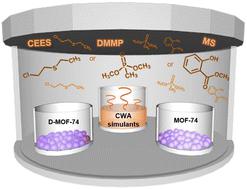当前位置:
X-MOL 学术
›
Dalton Trans.
›
论文详情
Our official English website, www.x-mol.net, welcomes your
feedback! (Note: you will need to create a separate account there.)
Defective MOF-74 with ancillary open metal sites for the enhanced adsorption of chemical warfare agent simulants
Dalton Transactions ( IF 3.5 ) Pub Date : 2023-08-12 , DOI: 10.1039/d3dt02025h
Sujeong Lee 1 , Sojin Oh 1 , Gihyun Lee 1 , Moonhyun Oh 1
Dalton Transactions ( IF 3.5 ) Pub Date : 2023-08-12 , DOI: 10.1039/d3dt02025h
Sujeong Lee 1 , Sojin Oh 1 , Gihyun Lee 1 , Moonhyun Oh 1
Affiliation

|
The development of effective porous adsorbents plays a vital role in eliminating hazardous substances from the environment. Toxic chemicals, including chemical warfare agents (CWAs), pose significant risks to both humans and ecosystems, highlighting the urgency to create efficient porous adsorbents. Therefore, substantial attention has been directed towards advancing adsorption techniques for the successful eradication of CWAs from the environment. Herein, we demonstrate a rational approach for enhancing the adsorption capability of a porous metal–organic framework (MOF) by employing ancillary open metal sites within the MOF structure. To generate defective MOF-74 (D-MOF-74) with ancillary open metal sites, some of the 2,5-dihydroxy-1,4-bezenedicarboxylic acid (DHBDC) linkers originally present in the MOF-74 structure were replaced with 1,4-benzenedicarboxylic acid (BDC) linkers. The absence of hydroxyl groups in the BDC linkers compared to the original DHBDC linkers creates ancillary open metal sites, which enhance the adsorption ability of D-MOF-74 for CWA simulants such as dimethyl methyl phosphonate, 2-chloroethyl ethyl sulfide, and methyl salicylate by providing effective interaction sites for the targeted molecules. However, excessive creation of open metal sites causes the collapse of the originally well-developed MOF-74 structure, resulting in a substantial reduction in its empty space and a subsequent decline in adsorption efficiency. Thus, to produce a defective MOF with the best performance, it is necessary to replace an appropriate amount of organic linker and create suitable open metal sites. Moreover, D-MOF-74 displays excellent recyclability during consecutive adsorption cycles without losing its original structure and morphology, suggesting that D-MOF-74 is an effective and stable material for the removal of CWA simulants.
中文翻译:

有缺陷的 MOF-74 具有辅助开放金属位点,用于增强化学战剂模拟物的吸附
有效多孔吸附剂的开发对于消除环境中的有害物质起着至关重要的作用。包括化学战剂 (CWA) 在内的有毒化学品对人类和生态系统构成重大风险,凸显了开发高效多孔吸附剂的紧迫性。因此,人们大力关注先进的吸附技术,以成功消除环境中的化学武器。在此,我们展示了一种通过在 MOF 结构内使用辅助开放金属位点来增强多孔金属有机框架 (MOF) 吸附能力的合理方法。为了生成具有辅助开放金属位点的有缺陷的 MOF-74 (D-MOF-74),最初存在于 MOF-74 结构中的一些 2,5-二羟基-1,4-苯二甲酸 (DHBDC) 连接体被替换为 1 ,4-苯二甲酸 (BDC) 连接体。与原始 DHBDC 连接体相比,BDC 连接体中不存在羟基,从而产生了辅助开放金属位点,从而增强了 D-MOF-74 对 CWA 模拟物(例如甲基膦酸二甲酯、2-氯乙基乙基硫醚和水杨酸甲酯)的吸附能力通过为目标分子提供有效的相互作用位点。然而,开放金属位点的过度产生会导致原本发育良好的MOF-74结构崩溃,导致其空位大幅减少,从而导致吸附效率下降。因此,为了生产具有最佳性能的有缺陷的MOF,有必要替换适量的有机连接体并创建合适的开放金属位点。此外,D-MOF-74在连续吸附循环过程中表现出优异的可回收性,而不会失去其原始结构和形态,这表明D-MOF-74是去除CWA模拟物的有效且稳定的材料。
更新日期:2023-08-16
中文翻译:

有缺陷的 MOF-74 具有辅助开放金属位点,用于增强化学战剂模拟物的吸附
有效多孔吸附剂的开发对于消除环境中的有害物质起着至关重要的作用。包括化学战剂 (CWA) 在内的有毒化学品对人类和生态系统构成重大风险,凸显了开发高效多孔吸附剂的紧迫性。因此,人们大力关注先进的吸附技术,以成功消除环境中的化学武器。在此,我们展示了一种通过在 MOF 结构内使用辅助开放金属位点来增强多孔金属有机框架 (MOF) 吸附能力的合理方法。为了生成具有辅助开放金属位点的有缺陷的 MOF-74 (D-MOF-74),最初存在于 MOF-74 结构中的一些 2,5-二羟基-1,4-苯二甲酸 (DHBDC) 连接体被替换为 1 ,4-苯二甲酸 (BDC) 连接体。与原始 DHBDC 连接体相比,BDC 连接体中不存在羟基,从而产生了辅助开放金属位点,从而增强了 D-MOF-74 对 CWA 模拟物(例如甲基膦酸二甲酯、2-氯乙基乙基硫醚和水杨酸甲酯)的吸附能力通过为目标分子提供有效的相互作用位点。然而,开放金属位点的过度产生会导致原本发育良好的MOF-74结构崩溃,导致其空位大幅减少,从而导致吸附效率下降。因此,为了生产具有最佳性能的有缺陷的MOF,有必要替换适量的有机连接体并创建合适的开放金属位点。此外,D-MOF-74在连续吸附循环过程中表现出优异的可回收性,而不会失去其原始结构和形态,这表明D-MOF-74是去除CWA模拟物的有效且稳定的材料。

































 京公网安备 11010802027423号
京公网安备 11010802027423号